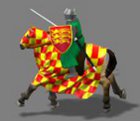| Fallen_KNiGHT_AC | Date: Thursday, 2011-07-21, 6:03 PM | Message # 1 |
 Colonel
Group: Administrators
Messages: 187
Status: Offline
| Treadmill shows medieval armour influenced battles
By Rebecca Morelle
Science reporter, BBC News

Medieval suits of armour were so exhausting to wear that they could have affected the outcomes of famous battles, a study suggests.
Scientists monitored volunteers fitted with 15th Century replica armour as they walked and ran on treadmills.
They found that the subjects used high levels of energy, bore immense weight on their legs and suffered from restricted breathing.
The research is published in the Proceedings of the Royal Society B.
The effect of the heavy armour was so great, that the researchers believe it may have have had an impact on the Battle of Agincourt.
Continue reading the main story
“
Start Quote
It is a huge fraction of the wearer's body weight”
End Quote
Dr Graham Askew
University of Leeds
In this famous Anglo-French conflict of 1415, French knights were defeated by their English counterparts, despite the fact that they heavily outnumbered them.
The researchers say their study suggests that the armour-clad French, who had to trek through a muddy field to meet the stationary English line, were so slowed and exhausted by their march that they would have stood little chance.
Lead researcher Dr Graham Askew, from the University of Leeds, said: "You look at these suits of armour, and they weigh between 30 and 50kg, so it is a huge fraction of the wearer's body weight."
Running battle
In the 15th Century, as the arms race progressed with the development of new and powerful weapons such as the longbow and crossbow, armour too evolved.
Researchers always suspected the armour would have been tough to wear In late Medieval Europe, these bulky battle suits were principally constructed from interlocking steel plates, covering the soldier from head to toe.
But with the added protection came extra weight and cumbersomeness - and while researchers have always realised that this would have impaired a soldier's performance, nobody until now has quantified by how much.
To study this, researchers asked four participants, who regularly re-enact battles for the Royal Armouries in Leeds, to don their exact-replica armour from England, Gothic Germany and Italy and get onto a treadmill.
By recording how much oxygen they took in and carbon dioxide they produced, the team was able to calculate how much energy they were using. High-speed cameras also helped the researchers to study how the volunteers were using their limbs.
Dr Askew, who carried out the research with colleagues from the University of Oxford and the University of Milan, said: "Our main finding was that it was extremely expensive in terms of the amount of energy used to move in the armour."
The team found that walking and running with the armour used up twice as much energy as doing the same thing without any armour.
The breast and back plates of the medieval armour also affected breathing: instead of being able to take long, deep breaths while they worked up a sweat, the volunteers were forced to take frequent, shallow breaths, and this too used up more energy.
Leg pains
Continue reading the main story
“
Start Quote
No-one wears stuff on the battlefield if it isn't useful”
End Quote
Thom Richardson
Royal Armouries, Leeds
The scientists also looked at how the volunteers performed while wearing armour compared with carrying the equivalent load on their backs, which is similar to the weight a modern soldier might carry in their backpack.
Dr Askew said: "We found there was a big difference: it is much more 'expensive' to carry the load as a suit of armour than it is to carry the load in a backpack.
"We were interested to find out why that was - and one of the main reasons is that if you wear a suit of armour, a lot of the weight is carried on the legs - about 7-8kg of it.
"And this means when you walk and you swing your legs, you are requiring a lot more muscular effort, and that costs you a lot more energy."
The team said their findings had given an insight into the battlefield trade-off between added protection alongside increased manoeuvrability and fitness to fight.
Weapons such as the cross bow changed the design of armour Dr Askew explained: "Yes, they could have removed the leg parts of the armour, but it might have meant they would have been cut on the leg and killed that way."
He added though, that this may not have been such a problem in the 16th Century.
With the advent of guns, hand-to-hand combat decreased, and this too affected the design of the armour.
He said: "It is interesting to see though that as armour developed into the 16th Century, the part of the armour that was lost was the lower leg - the thing that we found increases the cost of movement."
Thom Richardson, keeper of armours, from the Royal Armouries in Leeds added: "It is interesting to use scientific method to answer these questions, and it confirms what we have always suspected - heavy armour would very much reduce your ability to run around.
"But no-one wears stuff on the battlefield if it isn't useful."
Source: http://www.bbc.co.uk/news/science-environment-14204717
|
| |
| |





